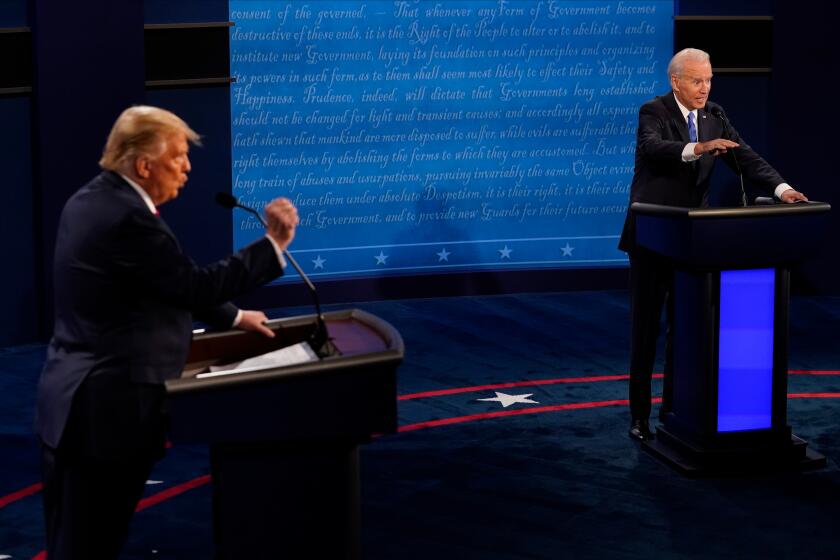Mitchell Health Plan Aims to Cover 95% of Americans
After weeks of intense consultation and negotiation with his uneasy troops, Senate Majority Leader George J. Mitchell (D-Me.) on Tuesday unveiled a plan that abandons much of President Clinton’s approach to health reform in favor of a more gradual one that expands coverage through voluntary incentives and hundreds of billions of dollars in government spending.
Mitchell’s proposal seeks to assure that at least 95% of Americans would have health insurance by the year 2000--which is short of Clinton’s bottom-line goal of guaranteed coverage for every American by a specific date, but is as far as the majority leader believes the Senate will go.
The proposal also seeks to make more palatable the element of the Clinton plan that many senators of both parties have said they would never accept: a requirement that employers pay a share of their workers’ health premiums.
Under Mitchell’s proposal, the so-called employer mandate would not take effect unless the voluntary measures and subsidies did not succeed in reaching the 95% coverage target. Even then, a government commission would first be given an opportunity to find other ways of reaching that level, and the mandate would not be imposed on states that meet the target.
Mitchell also would scale back the employer share, from Clinton’s proposed 80% to only 50%, and would exempt firms with fewer than 25 workers from having to pay anything.
The Congressional Budget Office has tentatively estimated that the voluntary measures will succeed in expanding coverage to 95%, from its current 85%, without triggering the mandate. Thus Mitchell’s plan provides a degree of political cover for senators who oppose mandates, because it gives them grounds to claim that the requirement would never go into effect.
With the release of the Mitchell plan, the stage for the congressional health care debate is set. On Friday, House Majority Leader Richard A. Gephardt (D-Mo.) released his proposal, which is significantly more far-reaching than Mitchell’s and includes an employer mandate similar to Clinton’s.
In a statement Tuesday, Clinton praised the Mitchell effort, saying that it “provides for” universal coverage and “achieves what the American people want--health coverage that can never be taken away.”
In a speech on the Senate floor, Mitchell described his proposal as “a voluntary system” that “builds on the existing American health care system of private insurance.”
“Health care reform is a matter of simple justice,” he said.
Attendance by senators from both parties was larger than usual as Mitchell delivered his remarks--a tribute to the enormous personal commitment that the majority leader has made to the health issue.
Mitchell gave up a chance for a Supreme Court nomination so that he would not be distracted in his fight to win passage. Indeed, as he prepares to retire at the end of the year, Mitchell clearly hopes to make health care legislation the crowning accomplishment of his Senate career.
Senate Minority Leader Bob Dole (R-Kan.) was the first to shake Mitchell’s hand after the speech. But he quickly made it clear that he plans to give no ground in the bruising debate that is set to begin Tuesday and is expected to last at least two weeks.
In a statement, Dole brushed aside Mitchell’s characterizations of his plan as a moderate approach, and said it “is very similar to President Clinton’s proposal in that it prescribes more government, more taxes and more entitlements.”
No final cost estimates are available, and many details of the Mitchell proposal remain to be filled in. Its main features, outlined in a 21-page summary, include:
* Subsidies that are aimed at helping low-income people and those who are temporarily unemployed afford coverage. By 1997, those earning below the poverty level (currently $14,800 for a family of four) would receive enough to pay their entire premium; smaller amounts would be available on a sliding scale for those earning up to 200% of poverty.
* A separate program of subsidies for children under 19 and pregnant women earning up to 300% of poverty level, with those under 185% receiving enough to pay their entire premium.
* Additional subsidies for employers who elect to begin covering workers who previously had no insurance.
* The establishment of voluntary purchasing cooperatives for individuals and firms employing fewer than 500 workers. The idea is to allow them to pool their buying power, so that they can negotiate better deals with insurance companies.
* A series of widely agreed upon changes in insurance industry practices, including provisions that would make it easier for people with known illnesses to buy coverage and for everyone to take their health insurance with them when they leave a job.
* A requirement that all employers offer their workers the chance to buy at least three types of insurance plans. No company is required to pay for that coverage, however.
* A benefits package that is less clearly defined than under Clinton’s proposal or the House bill. It includes 16 categories of covered services, including preventive care, mental health and substance abuse treatment and prescription drugs. For those under 22, there is also vision, hearing and dental care.
Abortion coverage is also on the list, but Mitchell conceded that issue is likely to be decided in a separate vote on the Senate floor.
One of the trickiest questions regarding the Mitchell proposal, as well as all of the alternatives, is how it would be paid for.
The vast new subsidy program, which Mitchell estimated would cost about $900 billion over 10 years, would largely be financed from savings that the government estimates it would reap from eliminating much of the current Medicaid program and moving those recipients into private plans.
Congressional aides said the shift could pay as much as 80% of the costs of the subsidies. States, meanwhile, would be required to send the amount that they are now spending on Medicaid to Washington to help finance the health reform effort.
Additionally, growth in Medicare spending would be trimmed by an estimated $54 billion over five years, and $278 billion over a decade, which is a somewhat smaller reduction than in either the Clinton bill or the House Democratic leadership plan. About half of that would go toward the new prescription drug benefit and a long-term care program, both of which would benefit the elderly the most.
The bill also includes new taxes, such as:
* A 45-cent-a-pack hike in the cigarette tax, which is the same as proposed in the House Democrats’ bill, but significantly lower than the 75-cent increase that Clinton suggested.
* A 1.75% tax on health premiums, which would be used to fund graduate medical education and teaching hospitals.
* A 25% assessment that individuals would pay on health premiums that are more expensive than average, which is aimed at discouraging people from buying the more generous health plans and is among the plan’s chief means of controlling costs.
Although it is still far from clear whether Mitchell has the 50 votes he needs to pass the proposal, it was favorably received by the senators whose support is most in question: moderate and conservative Democrats.
Sen. John B. Breaux (D-La.) called it “a major step in the right direction,” and praised it for relying on the market, rather than on “bureaucratic mandates and regulations.”
Added another moderate, Sen. Kent Conrad (D-N.D.): “I could support this bill. This bill has a very good chance of passing.”
Sen. Dianne Feinstein (D-Calif.) had quietly removed her name as an original co-sponsor of the Clinton bill after it encountered a firestorm of criticism. But Feinstein spokesman Bill Chandler said Tuesday night that she, too, regarded the Mitchell plan as “a major step in the right direction. . . . But the senator still has a number of unanswered questions, particularly about the cost and financing.”
Sen. Barbara Boxer (D-Calif.) has supported both the Clinton and Mitchell proposals.
Also on Tuesday, the Democratic House leadership agreed to delay, until at least next Thursday or Friday, floor debate on the health reform plan introduced last week by Gephardt.
Closing In on a Final Plan
A look at how the plan proposed by Senate Majority Leader George J. Mitchell (D-Me.) compares to the plan unveiled last week by House Democratic leaders and the President’s original plan:
UNIVERSAL COVERAGE
Senate Democrats: If 95% of Americans not covered by the year 2000, all businesses with 25 or more workers would have to split the cost of their workers’ insurance 50-50. Cigarette tax rises from 24 cents to 69 cents over five years. Imposes 1.75% tax on insurance premiums.
House Democrats: By 1999, require all companies to provide insurance to all workers. Employers to pay 80% of premiums, workers 20%. Increase cigarette tax by 45 cents a pack. Levy 2% tax on insurance premiums.
Original Clinton plan (used only as a blueprint, no longer an option): By 1998, require all companies to provide insurance to all workers. Employers to pay 80% of premiums, workers 20%. Increase cigarette tax by 75 cents a pack. Levy 1% tax on insurance premiums.
IMPACT ON MEDICARE
Senate Democrats: Expand Medicare coverage to cover prescription drugs. Includes new long-term program for the severely disabled.
House Democrats: Expand Medicare coverage to include prescription drugs. As state option, begins new long-term care program for some elderly Americans. New limits on payments to doctors and hospitals to rein in rate of increase in costs.
Original Clinton plan (used only as a blueprint, no longer an option): Same, except long-term care would be required, not an option.
SUBSIDIES FOR SMALL BUSINESS
Senate Democrats: Subsidies for firms that expand coverage to all their workers. These firms would pay the lesser of 50% of the premium or 8% of each newly insured employee’s wages. Subsidy ends after five years.
House Democrats: Provide tax credits for companies of up to 50 workers. Subsidy amount varies by size and payroll. Offers companies two options other than arranging for insurance on their own: enroll workers in the new Medicare Part C program or let them buy into existing federal employees health program.
Original Clinton plan (used only as a blueprint, no longer an option): Provide subsidies to businesses, depending on size and average payroll.
INSURANCE REFORM
Senate Democrats: Insurers could charge older customers twice as much as younger customers. Firms with fewer than 500 individuals would be in community-rated pools.
House Democrats: Allow states either voluntary or mandatory purchasing pools. Forbids insurance companies from charging some customers more than others. Would eliminate pre-existing condition exclusions.
Original Clinton plan (used only as a blueprint, no longer an option): Requires all but the largest companies to buy insurance through purchasing pools. Forbids insurance companies from charging some customers more than others. Eliminates pre-existing condition exclusions.
COST CONTAINMENT
Senate Democrats: Imposes 25% tax on high-cost health plans for the amount which they exceed a target cost. Creates national panel to monitor expenditures and recommend ways to hold down costs.
House Democrats: Effective in 2001, authorizes the government to establish standby price controls on insurance premiums if a national commission deemed them necessary.
Original Clinton plan (used only as a blueprint, no longer an option): Effective immediately, establisheds standby federal price controls on insurance premiums.
Source: Times Washington Bureau, Associated Press
More to Read
Start your day right
Sign up for Essential California for news, features and recommendations from the L.A. Times and beyond in your inbox six days a week.
You may occasionally receive promotional content from the Los Angeles Times.






